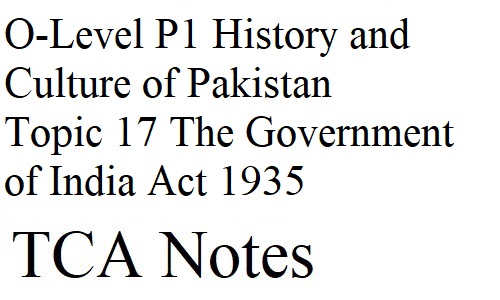O Level P1 History and Culture of Pakistan Topic 17 The Government of India Act 1935
To view notes of Pakistan Studies Paper 1 History and Culture of Pakistan. Click Here.
The Government of India Act 1935
The Government of India Act 1935 was passed during the "Interwar Period" and was the last pre-independent constitution of India. Government of India Act was enforced on the basis of recommendations of the Simon Commission (1927) & the reports of RTCs (1930-32)
The Act was originally passed in August 1935, and is said to have been the longest (British) Act of Parliament ever enacted by that time. Because of its length the Act was split by the Government of India Act 1935 into two separate Acts:
- The Government of India Act 1935
- The Government of Burma Act 1935
Key Points:
Main provisions of Government of India Act 1935 were as follows.
- Federal system of government will be followed with 11 provinces & all states which agreed to join it.
- Principle of provincial autonomy will be followed.
- Three lists of subjects were chalked out. Central subjects were Defense, Foreign affairs, Currency & Communication .Provincial subjects were education, Health, Public works & Agriculture. Concurrent subjects were those on which both could legislate, but central had the priority.
- Central Legislature had two houses. The Upper house had 260 members & the Lower house had 375 members.
- Autonomy was given to all provinces. All provincial subjects were given to Indian minister who were responsible to the Legislative Assembly of the province.
- Women for the first time were given the right to vote.
- Right of separate electorate was maintained for Muslims & other communal groups.
- System of Diarchy ended in the provinces & was taken to the centre.
- New provinces of Orissa, Sindh & NWFP were formed & were given full provincial status.
- Provision for the establishment of a "Federation of India", to be made up of both British India and some or all of the "princely states"
- The introduction of direct elections, thus increasing the franchise from seven million to thirty-five million people
- Sind was separated from Bombay
- Bihar and Orissa was split into the separate provinces
- Burma was completely separated from India .
1937 Elections:
Provincial elections were held in British India in the winter of 1936-37 as mandated by the Government of India Act 1935. Elections were held in eleven provinces - Madras, Central Provinces, Bihar, Orissa, United Provinces, Bombay Presidency, Assam, NWFP, Bengal, Punjab and Sindh.
The final results of the elections were declared in February 1937. The Indian National Congress emerged in power in eight of the provinces - the three exceptions being Bengal, Punjab, and Sindh. The All-India Muslim League failed to form the government in any province. The Congress ministries resigned in October and November 1939, in protest against Viceroy Lord Linlithgow's action of declaring India to be a part of the Second World War without consulting the Indian people.
The 1937 election was the first in which large masses of Indians were eligible to participate. (Approx. 30.1 million people). The results were in favour of the Indian National Congress. Of the total of 1,585 seats, it won 707 (44.6%). Among the 864 seats assigned "general" constituencies, it contested 739 and won 617. The All-India Muslim League won 106 seats (6.7% of the total), placing it as second-ranking party. The only other party to win more than 5 percent of all the assembly seats was the Unionist Party (Punjab), with 101 seats.
Why was the Govt. of India Act of 1935 so important to the future of the sub continent?
The British government was bound to introduce such constitutional scheme for India which could be practicable & acceptable to all sections of Indian society. The act of 1935 was an unusual piece of constitutional legislation & that remained a source of inspiration for the future constitutional reforms in the sub continent.
It was important to the future of the sub continent because it was the last constitutional reforms with which the British wanted to give political power in the hands of Indians. Through this Act the federal system & parliamentary system were enforced in India. The members of Central Assembly were greatly enlarged. The number of voters was greatly increased i.e. from 6 million to 30 million & women were also allowed to vote.
Autonomy was given to all the provinces & all the ministers were to be Indians. Every province was free to formulate its programme & execute it. In other words Indians were involved in the management of the affairs of the land. New provinces of Orissa, Sindh & NWFP were created. The Act was also important because it became the basis of future constitutions of both India & Pakistan after independence; the government of Pakistan was running on the 1935 Act till 1956 when the first constitution of the country was enforced.


